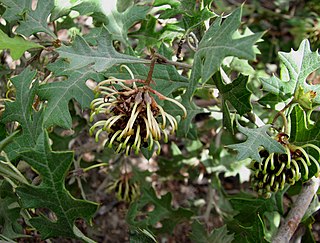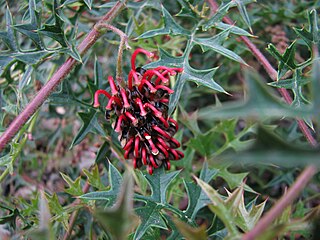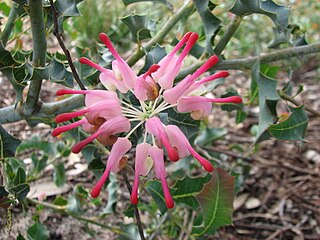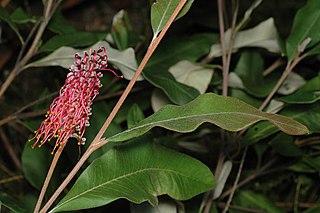
Grevillea miniata, commonly known as sandstone grevillea, is a species of flowering plant in the family Proteaceae and is endemic to north-western Australia. It is a spreading to erect shrub or small tree with more or less oblong leaves and bright yellow to orange and bright red flowers with a yellow style.

Grevillea pilosa is a species of flowering plant in the family Proteaceae and is endemic to the south-west of Western Australia. It is a spreading to prostrate shrub with wedge-shaped to oblong leaves with sharply pointed, more or less triangular teeth or lobes, and clusters of pale pink to rose-pink or red flowers.

Grevillea floripendula, commonly known as Ben Major grevillea or drooping grevillea, is a species of flowering plant in the family Proteaceae and is endemic to a restricted area of Victoria, Australia. It is a spreading, low-lying to prostrate shrub with divided leaves with toothed lobes and clusters of greenish to mauve and blackish flowers with a yellow to red style.

Grevillea dryophylla, also known as Goldfields grevillea, is a species of flowering plant in the family Proteaceae and is endemic to Victoria, Australia. It is a spreading to erect shrub with hairy branchlets, lobed leaves, and green to brown or yellow flowers.

Grevillea obtecta, commonly known as Fryerstown grevillea, Elphinstone grevillea or Taradale grevillea, is a species of flowering plant in the family Proteaceae and is endemic to Victoria in Australia. It is a prostrate, clumping or straggling shrub with pinnatifid, pinnatipartite or toothed leaves, and toothbrush-like clusters of light green to yellowish and purplish to black flowers with a dull yellow to pink style.

Grevillea infecunda, commonly known as Anglesea grevillea, is a species of flowering plant in the family Proteaceae and is endemic to a restricted area of southern Victoria in Australia. It is a low-lying to weakly erect shrub with divided leaves with three to sixteen lobes or teeth and greenish-yellow flowers with a dull pink style.

Grevillea montis-cole, commonly known as Mount Cole grevillea, is a species of flowering plant in the family Proteaceae and is endemic to central-western Victoria, Australia. It is a shrub with divided leaves with 5 to 15 lobes, the end lobes more or less triangular to narrowly oblong and sharply-pointed, and clusters of greenish to fawn and dull purplish flowers.

Grevillea oldei is a species of flowering plant in the family Proteaceae and is endemic to a small area of eastern New South Wales. It is a diffuse shrub with narrowly egg-shaped to more or less triangular leaves, and red flowers.

Grevillea acrobotrya is a species of flowering plant in the family Proteaceae and is endemic to the southwest of Western Australia. It is a prickly, spreading to erect shrub with egg-shaped to trowel-shaped leaves with sharply-tipped lobes, and white to cream-coloured flowers with smaller leaves at the base.

Grevillea oxyantha is a species of flowering plant in the family Proteaceae and is endemic to south-eastern continental Australia. It is an erect to spreading shrub with somewhat silky-hairy branchlets, broadly elliptic to broadly egg-shaped or almost round leaves, and hairy, crimson and pink flowers with a red style.

Grevillea bemboka is a species of flowering plant in the family Proteaceae and is endemic to a restricted area of far south-eastern New South Wales. It is a spreading to erect shrub with hairy branchlets, egg-shaped to elliptic leaves and red or reddish-pink flowers.

Grevillea formosa, also known as the Mount Brockman grevillea, is a species of flowering plant in the family Proteaceae and is endemic to Arnhem Land in the Northern Territory. It is a prostrate to sprawling shrub with deeply divided leaves, the lobes sometimes further divided, the end leaflets linear, and green flowers that turn bright golden-yellow.
Grevillea longicuspis is a species of flowering plant in the family Proteaceae and is endemic to a small area of the Northern Territory in Australia. It is a shrub with divided leaves that are egg-shaped in outline with sharply-pointed teeth or lobes, and clusters of red flowers with a red or creamy pink style.

Grevillea insignis, commonly known as wax grevillea, is a species of flowering plant in the family Proteaceae and is endemic to the south-west of Western Australia. It is an erect, bushy shrub with more or less oblong leaves with seven to seventeen sharply-pointed, triangular teeth, and more or less spherical or cylindrical clusters of cream-coloured flowers ageing to pink.

Grevillea glauca, commonly known as bushman's clothes peg, cobblers peg tree, beefwood tree, nut wood, nalgo, or kawoj in New Guinea, is a species of flowering plant in the family Proteaceae and is native to Papua New Guinea and north-eastern Queensland. It is an erect, spindly shrub or small tree with narrowly egg-shaped to elliptic leaves, and cylindrical clusters of cream-coloured to greenish-white flowers.

Grevillea macleayana, commonly known as Jervis Bay grevillea, is a species of flowering plant in the family Proteaceae and is endemic to south-eastern New South Wales. It is a spreading shrub with egg-shaped to elliptic, sometimes lobed leaves, and greenish or greyish flowers with a pink to red style.
Grevillea cunninghamii is a species of flowering plant in the family Proteaceae and is endemic to the north of Western Australia. It is a shrub with egg-shaped leaves with sharply-pointed teeth on the edges, and clusters of red flowers.

Grevillea erinacea is a species of flowering plant in the family Proteaceae and is endemic to the south-west of Western Australia. It is a spreading shrub with deeply-divided leaves with three to five linear lobes, rotated through 90°, and cream-coloured flowers with a white style.

Grevillea goodii, also known as Good's grevillea, is a species of flowering plant in the family Proteaceae and is endemic to the Northern Territory. It is a prostrate shrub with egg-shaped to narrowly elliptic leaves and clusters of light green flowers with a pink to red style.
Grevillea ceratocarpa is a species of flowering plant in the family Proteaceae and is endemic to inland areas of the south-west of Western Australia. It is an erect or spreading shrub with softly-hairy, narrowly elliptic or narrowly egg-shaped leaves with the narrower end towards the base, and creamy-white flowers.
















